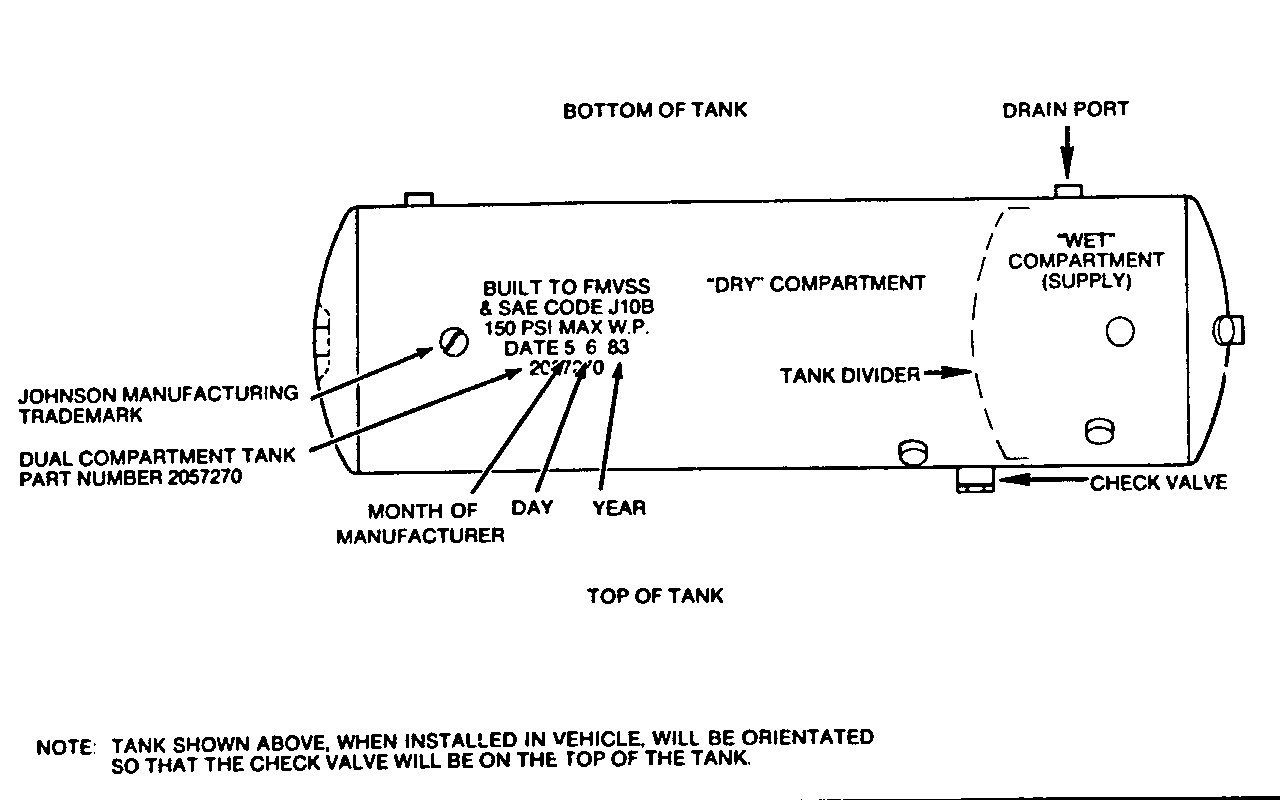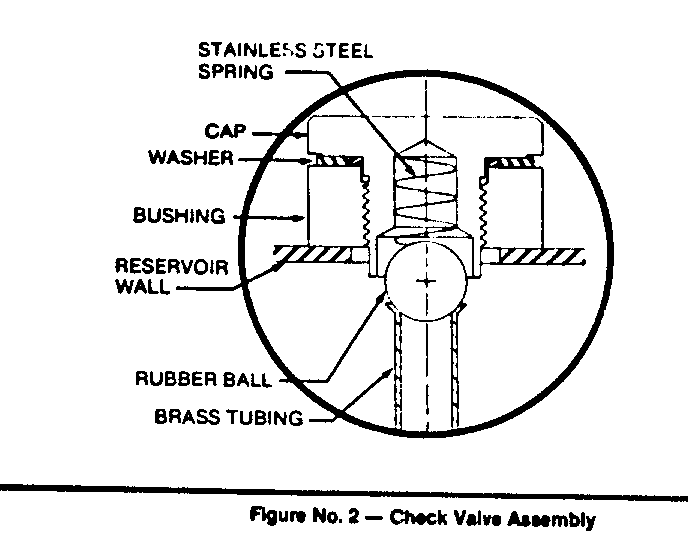CAMPAIGN: AIR BRAKE RESERVOIR CHECK VALVE MAY FAIL

SUBJECT: DUAL AIR RESERVOIR TANK CHECK VALVE MAY FAIL
MODELS: 1993 C6, C7 SINGLE OR TANDEM REAR AXLE AND P6T042 MEDIUM DUTY MODEL TRUCKS EQUIPPED WITH AIR BRAKES-RPO JE4
The National Traffic and Motor Vehicle Safety Act, as amended, provides that each vehicle which is subject to a recall campaign of this type must be adequately repaired within a reasonable time after the owner has tendered it for repair. A failure to adequately repair within 60 days after tender of a vehicle in prima facie evidence of failure to repair within a reasonable time.
If the condition is not adequately repaired within a reasonable time, the owner may be entitled to an identical or reasonably equivalent vehicle at no charge, or to a refund of the purchase price less a reasonable allowance for depreciation.
To avoid having to provide these burdensome solutions, every effort must be made to promptly schedule a service date with each owner and to repair their vehicle as soon as possible. As you will see in reading the attached copy of the letter which is being sent to owners, the owner is being instructed to contact the nearest GMC Zone Office if their dealer does not remedy the condition within five days of the mutually agreed upon service date. If the condition is not remedied within a reasonable time, they are instructed how to contact the National Highway Traffic Safety Administration.
DEFECT INVOLVED
General Motors has determined that a defect which relates to motor vehicle safety exists in some 1983 C6, C7 and P6 medium duty trucks equipped with air brakes (RPO JE4). Some trucks were built with a carbon steel spring installed in the dual air reservoir tank check valve, instead of the specified stainless steel spring. In this application, the carbon steel spring could rust and allow the check valve to fail. If an air leak were to develop in the rear primary brake system, a failed check valve could result in complete loss of the front and rear service brake systems.
If an air leak were to occur. a low pressure warning buzzer and light would alert the driver to the loss of the service brake system. If the driver were to fail to heed these warnings, a vehicle crash could occur.
Dealers are to inspect each truck, as described in the Service Procedure, to determine the correction procedure required.
VEHICLES INVOLVED
Involved are certain 1983 C6, C7 single or tandem rear axle and P6T042 medium duty model trucks equipped with air brakes (RPO JE4). Vehicles involved were built within the following VIN breakpoints:
Plant From Through ------- -------- -------- Pontiac DV504349 DV534811
The specific vehicles involved in this campaign have been identified by Vehicle Identification Number Computer Listings. These listings are furnished to all involved dealers with the campaign bulletin.
DEALER CAMPAIGN RESPONSIBILITY
Dealers are to service all vehicles subject to this campaign at no charge to owners, regardless of mileage, age of vehicle, or ownership, from this time forward.
Whenever a vehicle subject to this campaign is taken into your new or used vehicle inventory, or it is in your dealership for service in the future, you should take the steps necessary to be sure the campaign correction has been made before reselling or releasing the vehicle
Owners of vehicles recently sold from your new vehicle inventory are to be contacted by the dealer, and arrangements made to make the required modification according to instructions contained in this bulletin.
If no owner's name and address were available to GMC Truck at the time of campaign initiation. the dealer will determine the owner's name and address from the dealership sales record. Please provide this information directly on the second copy of the listing next to the applicable VIN, so that our records may be updated and the appropriate notification mailed to the owner. This second copy should then be submitted to the address listed below in the previously supplied yellow campaign envelopes.
GMC Truck General Motors Corporation 101 Union Street Plymouth, Michigan 48170
OWNER NOTIFICATION
Owners will be notified of this campaign on their vehicles by GMC Truck (see copy of Owner Letter included with this bulletin). A listing of owner names and addresses has been furnished to the involved dealers to enable dealers to follow up with owners involved in this campaign. This listing may contain owner names and addresses obtained from state motor vehicle registration records. The use of such motor vehicle registration data for any other purpose is a violation of law in several states. Accordingly, you are urged to limit the use of this listing to this campaign.
INSPECTION PROCEDURE
1. Inspect each truck to determine if equipped with a dual compartment air reservoir tank (see Figure 1).
If truck is not equipped with a dual compartment air reservoir tank no further action is required.
2. If truck is equipped with a dual compartment air reservoir tank, inspect tank for Johnson Manufacturing Trademark and date code (See Figure No. 1).
It may be necessary to remove foreign material and paint with suitable cleaner or abrasive to read stamped trademark and date code.
If truck is not equipped with a Johnson dual compartment air reservoir tank, identified by the Johnson Manufacturing Trademark, no further action is required.
3. Trucks equipped with Johnson Manufacturing dual compartment air reservoir tanks that have a stamped date code within and including the following build date codes require check valve assembly replacement
FROM THROUGH
10-26-82 6-5-83
SERVICE PROCEDURE CHECK VALVE ASSEMBLY REPLACEMENT
1. Block vehicle wheels.
2. Drain all air reservoirs to 0 psi (0 kPA).
3. Remove the cap from the check valve (reference Figure Nos. 1 & 2). Be careful in doing this as the cap compresses the spring and rubber ball.
4. Remove and discard spring, washer and rubber ball (See Figure No. 2). Clean valve seat area.
5. Reassemble using parts from check valve repair kit. P/N 15529164, (Figure No. 2). Torque cap to 55-65 ft. lbs. (75-88 Nm).
6. Build up air pressure in brake system and turn engine off. Note air pressure on air pressure gage in the instrument panel, it should read approximately 120 psi (827 kPA).
7. Deplete the air pressure in the supply side of the air reservoir tank, close drain port of tank (see Figure No. 1) and wait 15 minutes.
8. Again note pressure reading on air pressure gage. The air pressure on gage should again read approximately 120 psi (827 kPA). Next slowly open the drain port on the air reservoir tank and listen for any air escape. If there is air leakage, the check valve should be rechecked for proper assembly, Figure No. 2, and steps 6, 7 and 8 of the procedure repeated.
NOTICE: Always make sure that the brakes are operational after performing brake work and before returning the vehicle to service.
PARTS INFORMATION
Parts are to be obtained from the Warehousing and Distribution Division of General Motors (WDDGM). To ensure that these parts will be obtained as soon as possible, they should be ordered from WDDGM on a C.I.O. order with no special instruction code, but order on an advise code (2).
Trucks requiring replacement of the dual air reservoir tank check valve assembly will need the following repair kit.
Part Quantity Number Per Vehicle Description -------- ----------- --------------------- 15529164 1 Check Valve Repair Kit - 1 Stainless Steel Spring 1 Rubber Check Ball 1 Washer
WARRANTY INFORMATION
Dealer should submit an accurately filled out Warranty Repair Order on each vehicle completed under this campaign.
Labor Operation *Time Trouble Number Description Allowance Code --------- ------------------------------ --------- ----- V2350 Inspect for dual compartment air 0.2 hr. 96 reservoir tank and/or Johnson Manufacturing Trademark and Date Code.
V2351 Inspect and install check valve 0.6 hr. 96 repair kit.
CAMPAIGN IDENTIFICATION LABEL
Each vehicle modified in accordance with the instructions outlined in this product campaign bulletin will require a "Campaign Identification Label". Each label provides a space to include the five (5) digit Dealer Code of the dealer performing the campaign service. This information may be inserted with a typewriter or ballpoint pen.
Each "Campaign Identification Label" is to be located on the radiator core support in an area which will be visible when the vehicle is brought in for periodic servicing by the owner.
Apply "Campaign Identification Label" only on a clean dry surface.
ADMINISTRATIVE PROCEDURE
Procedures covering this campaign are outlined in Section V of your dealership's "GMC Truck Claims Processing Manual" issued April, 1983.


General Motors bulletins are intended for use by professional technicians, not a "do-it-yourselfer". They are written to inform those technicians of conditions that may occur on some vehicles, or to provide information that could assist in the proper service of a vehicle. Properly trained technicians have the equipment, tools, safety instructions and know-how to do a job properly and safely. If a condition is described, do not assume that the bulletin applies to your vehicle, or that your vehicle will have that condition. See a General Motors dealer servicing your brand of General Motors vehicle for information on whether your vehicle may benefit from the information.
